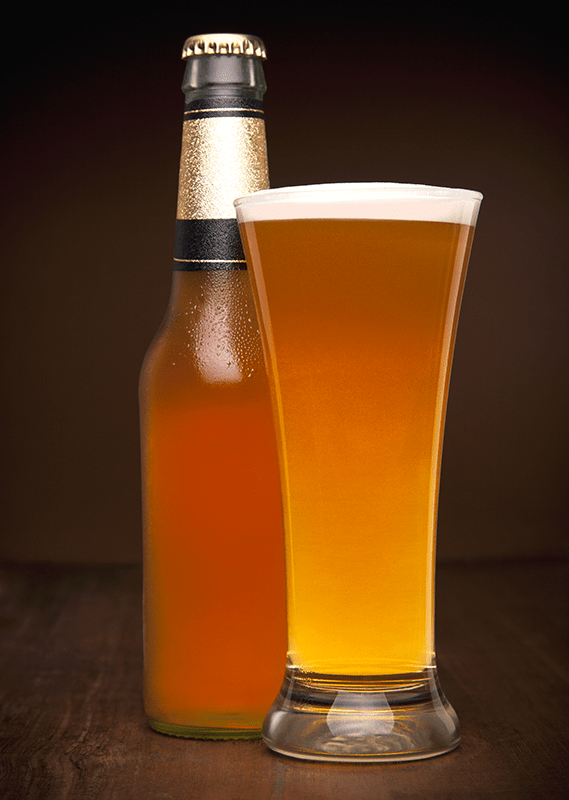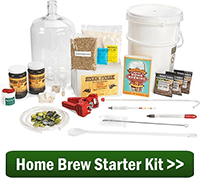 Have you ever heard of braggot beer? Braggot (also spelled bragot, bragaut, bracket, brackett, bragawd) is simply a hybrid between a beer and a mead, or a beer fortified with honey. I dove into Randy Mosher’s book Radical Brewing to learn a little more about brewing a braggot and discovered an easy braggot beer recipe for both extract and all-grain brewing.
Have you ever heard of braggot beer? Braggot (also spelled bragot, bragaut, bracket, brackett, bragawd) is simply a hybrid between a beer and a mead, or a beer fortified with honey. I dove into Randy Mosher’s book Radical Brewing to learn a little more about brewing a braggot and discovered an easy braggot beer recipe for both extract and all-grain brewing.
Some Braggot History
With all the different types of beers out there and all the varieties of honey, to define a braggot (as one writer puts it) “with any degree of preciseness would be as difficult as to give an accurate definition of ‘soup.’” A braggot beer style is one that is hard to define. Though the name for braggot suggests origin in the British Isles, honey beers have been made for thousands of years in various regions around the world. The Hymn to Ninkasi, a Sumerian text dating to 1800 BC, mentions honey as a brewing ingredient.
Braggot seems to have gained some popularity in England in the mid-1500s. In addition to malt and honey, various herbs, spices, and fruits often found their way into a braggot beer recipe. Various accounts include cinnamon, pepper, cloves, heather, and ginger. Except for the most recent interpretations, hops were probably not used in braggot beer. Alcohol content was likely high. According to Mosher, braggot essentially disappeared in the mid-1800s and didn’t make a comeback until the recent homebrewing movement.
Brewing a Braggot Beer Recipe
Because of the elusive bragget beer style, as might be expected, the BJCP Guidelines for braggot give the homebrewer a lot of leeway. The overall impression should be “a harmonious blend of mead and beer, with the distinctive characteristics of both.” If using a base beer style, the braggot should retain some characteristics of that style. Other than that, pretty much anything goes, though the brewer should pay special attention to the characteristics of the particular honey being used.
Based on my experience, I recommend adding honey to a tried and true beer recipe (something that isn’t too hoppy, like a brown ale) to get a sense of the honey’s flavor, aroma, effect on fermentation, etc. Start with a pound of honey in a five-gallon batch, then increase to two pounds the next time around. Eventually you will find the balance that you enjoy. To preserve the aromatic qualities of the honey, I suggest adding it at the end of the boil, pouring it into the wort right after you turn off the heat.
 If you’re ready to take the plunge with a more adventurous braggot beer recipe, try this one from Radical Brewing:
If you’re ready to take the plunge with a more adventurous braggot beer recipe, try this one from Radical Brewing:
BRONZE AGE BRAGGOT BEER RECIPE
Specifications
Batch Size: 5 gallons
OG: 1.100
ABV: 12-13.5%
IBUs: none
Ingredients (Braggot Recipe All-Grain)
8 lbs. wheat malt
8 lbs. cranberry honey
1 lb. two-row malt
0.1 oz. bog myrtle
1 wintergreen Lifesaver and a few drops of liquid smoke (or a few ounces of smoked malt)
1 packet wine yeast (such as Lalvin D-47)
Ingredients (Braggot Extract Recipe)
6 lbs. Wheat LME
8 lbs. cranberry honey
0.1 oz. bog myrtle
1 wintergreen Lifesaver and a few drops of liquid smoke (or a few ounces of smoked malt)
6 lbs. cranberries, frozen then thawed (or 1/2 gallon of pure cranberry juice)
1 packet wine yeast (such as Lalvin D-47)
Directions: For all-grain, mash the grains with 1.5 qts. of water and hold at 150°-154°F. for 60 minutes. Sparge to collect 3-4 gallons of wort and bring to a boil. (For extract, mix LME with 3 gallons water and bring to a boil.) Add the bog myrtle and boil for 60 minutes. Turn off the heat and add the Lifesaver and liquid smoke (if not using smoked malt). Mix in the honey. If needed, top off with enough clean water to make five gallons.
Cool to about 60°F., aerate, and pitch yeast. Towards the end of primary fermentation, transfer to a sanitized secondary fermenter containing the cranberries or cranberry juice. Allow to ferment for an additional 2-4 weeks, then transfer to a third fermenter and allow to clear. Traditionally, this type of braggot beer would be still, but you may carbonate if you wish.
A final word of advice: Whenever doing heavy homebrew experimentation, it’s a good idea to start with a small batch, as little as one gallon. Honey can be expensive, so it’s worth giving your braggot a few tries to get the braggot beer recipe right. You may wish to cut the above recipe in half the first time around.
Have you made a braggot before? Share your tips in the comments!
—–
David Ackley is a beer writer, brewer, and self-described “craft beer crusader.” He holds a General Certificate in Brewing from the Institute of Brewing and Distilling and is founder and editor of the Local Beer Blog.

“1 wintergreen Lifesaver” I’m wondering what this is for. I’m thinking of making a 1 gallon batch. I So I’m thinking of not putting it in. So this leads me to ask why is it there in the first place. I don’t see yo putting in any yeast nutrients, is that what it’s for?
Gary, the lifesaver is added strictly for flavoring. If you omit the lifesaver from your one-gallon batch the beer will still turn out just fine.
I made a honey braggot ale last year. I didn’t realize how high the gravity was and the yeast I pitched didn’t seem to fully attenuate. I tried a bottle or two within a month and it tasted terrible, too sickly sweet. I have the remaining bottles resting on their side somewhere hidden in a dark and cool place (I swirl the yeast sediment in the bottom every once in a while). I guess I’ll try it again in a year?
If you desire a dryer finish I’d highly suggest brewing with ‘raw’ honey – the fresher the better and treat your honey as you would yeast as it has enzymes within in. The fragile enzyme called Amylase breaks down at approximately 64 degrees C. It’s the Amylase which is responsible for breaking down complex sugars such as starch and in the right conditions can fully attenuate high gravity brews.
Please note you won’t / will struggle to find raw honey that has not been heat treated in your local supermarket – scout out a local beekeeper and buy in bulk!
I made a braggot with 3 gallons saison base, 10 lbs of honey, 1 pound of peaches, with brettanomyces. It sat for almost a year in secondary. Bottled and let sit for several more. Final result was a saison with a meady finish bridged by the subtle hint of peaches countered with a pleasurable funk from the Bret. Final gravity was a dryer 1.01 estimated ABV to be 16% but the math got tricky. Next time I’ll probably up the peaches a little but otherwise I am pretty proud of the end product.
I think that qualifies as a mead. Braggot would be more grain than honey.
I got here after reading about braggot in the Oxford Companion to Beer. On page 155, it says “Various options are possible depending on the balance of malt and honey used, but in strict terms there should be more honey than malt to distinguish braggot from a honey beer.” So is Bahlke’s brew a braggot or a mead or a beer? I don’t pretend to really know, but I wish I could try it. It sounds magical. Regardless of who is “right” the above recipe also sounds very nice. I think I will make it soon.
Confused about the smoked malt. How many ounces exactly and when to add (pre, during, post boil)? Thanks.